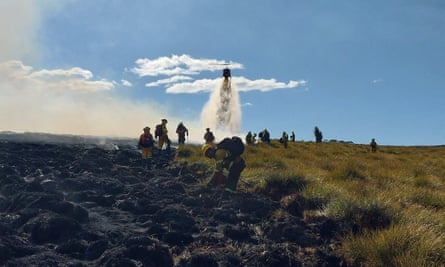Major flooding, dumping rain, heatwaves, cyclone watch and potential snow will round out a week of changeable weather across Australia.
An already saturated north Queensland is at risk of more flooding, with more heavy rainfall forecast until Wednesday afternoon. Two people have died in flood waters that have cut off towns and left many without power.
Angus Hines, senior meteorologist at the Bureau of Meteorology, warned that “further rainfall is not going to be able to soak into the landscape.
“It’s going to immediately run off and make its way into the river network, and that is going to prolong the riverine flooding,” he said.
Farther south, severe thunderstorms ripped across New South Wales and eastern Victoria on Monday, bringing flash flooding, destructive winds and hail.
What can we expect this week?
Southern parts of Australia will experience “quite an up and down spell of weather this week”, Hines said.
A heatwave set to bake the south-east will make South Australia swelter on Wednesday with temperatures up to 15C hotter than normal, and 5 to 10C above average in Victoria and Tasmania, according to forecasts.
In Tasmania, bushfires in the central and northwest regions have burned through 45,000 hectares. The fires have closed the popular Overland Track hiking trail and are threatening a grove in Takayna/Tarkine which contains the oldest known Huon pine tree, an estimated 3,000 years old. In 2019, 15 of the 25 tallest trees in Tasmania were incinerated by bushfire.
Ignited by lightning strikes, the fires burn as the state faces severe heatwave warnings. “With the hot and quite windy conditions, we’re only going to see those fires get a bit more treacherous in the next few days,” Hines said.
A cold front and February snow
However, a cold front is set to sweep north over Tasmania at the end of the week, accompanied by “a statewide soaking”, Weatherzone has predicted.
In parts of Tasmania and Victoria, temperatures will drop from 10 or 12C warmer than average to about 5 to 8C cooler than average by the weekend, Hines said.

Summer snow is possible on the weekend from altitudes of 900m in Tasmania and elevations upwards of 1,300m in Victoria and 1,500m in southern NSW.
after newsletter promotion
Tropical cyclone brewing
Meanwhile, in Western Australia, a tropical low called 18U has formed off the west coast of the Kimberley. It is forecast to intensify into a tropical cyclone on Wednesday or Thursday. To be named Cyclone Zelia, it may make landfall around the Pilbara region at the end of the week.
“There’s definitely a good chance it could swing over parts of northern WA, bringing fairly extensive rain and storm activity,” Hines said.
It comes after a prolonged marine heatwave that has affected waters of the WA coast since September, causing mass fish deaths. WA has also experienced several prolonged heatwaves this summer, with January temperature records broken in multiple towns. A severe heatwave in the interior part of the state is ongoing.
What’s causing the wild weather?
“When we’re talking about snow in February, particularly in the same week that we’re talking about heatwaves and fire danger, it’s pretty unusual,” Hines said.
Andrew King, an associate professor in climate science at the University of Melbourne, said while “it does feel like there’s a lot going on” that it is actually “quite common” at this time of year for different types of extreme weather happening in various parts of the continent.
“This is severe weather season for Australia,” King said. “Typically this is the time of year we would see heatwaves with vigorous cold fronts causing big changes. It’s also the time of year we expect to see the potential for very heavy rain in parts of northern Australia, and the potential for tropical cyclones or tropical lows.
“It’s also the time of year when we have the highest likelihood of things like extreme rainfall that causes flash flooding in places like Sydney.”
With its variable rainfall trends, Queensland was a different case, King said. “I would suspect that there is a bit of a climate change influence on that extreme rainfall, but it’s probably not the main part of the story.”
Anthropogenic global heating is increasing the intensity and severity of heatwaves and fire weather conditions, while each additional 1C in global temperature is also linked to a 7% intensification in rainfall.
Last year was the hottest year on record, with European data suggesting the worldwide average temperature was 1.6C warmer than preindustrial times, a rise that exceeded the internationally agreed 1.5C target for the first time.

 3 months ago
107
3 months ago
107

















































